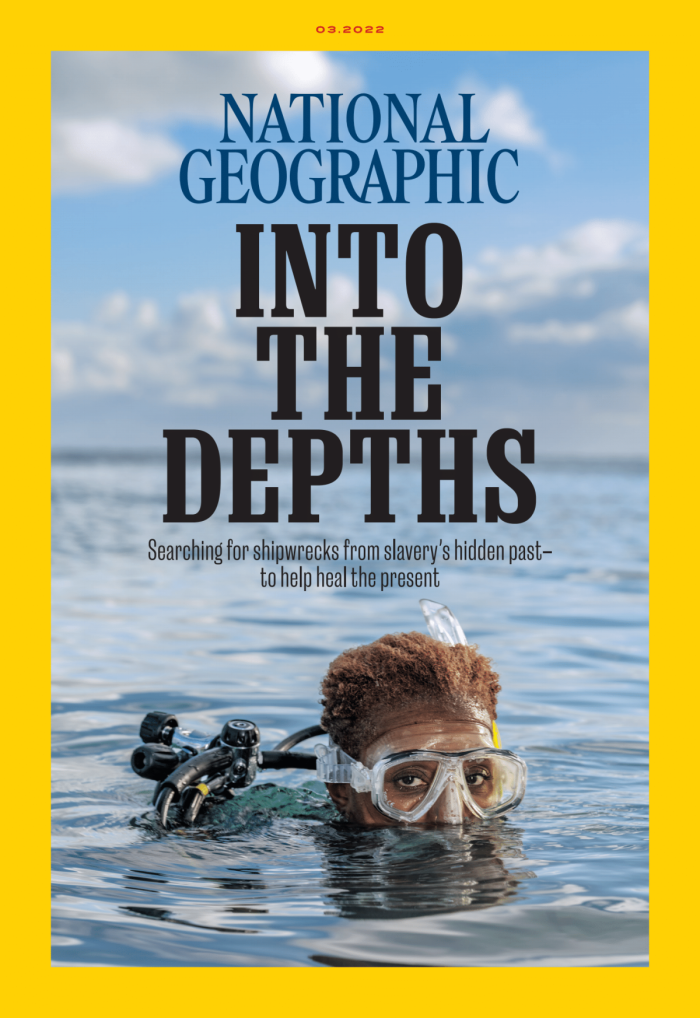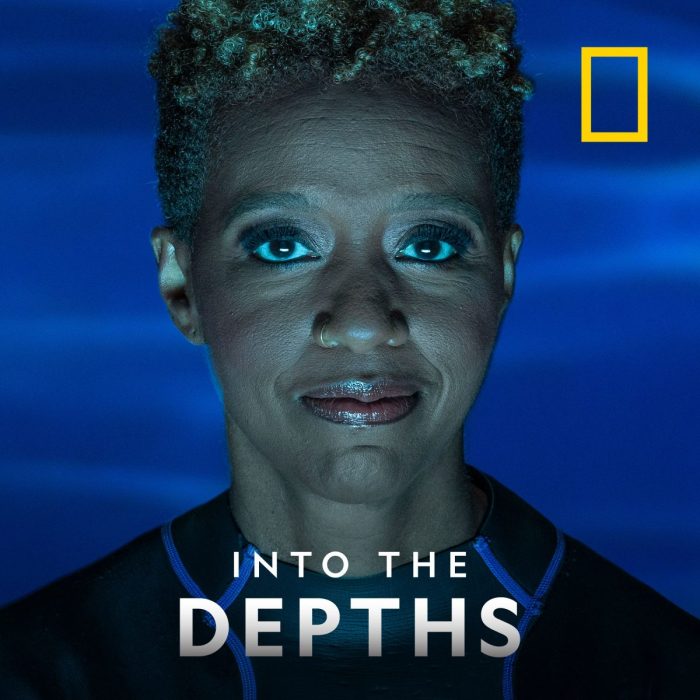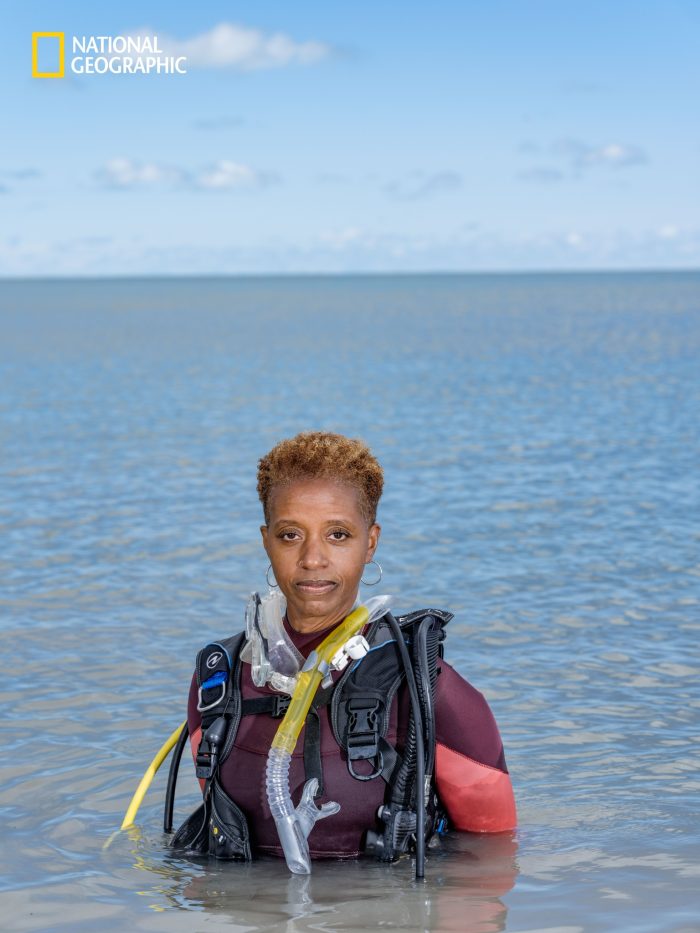
Source: Wayne Lawrence / National Geographic
Over the last year, National Geographic Explorer and Storytelling Fellow Tara Roberts has been following an all-Black team of expert scuba divers from a nonprofit organization called Diving With A Purpose in search of clues, fragments, and artifacts underneath the ocean that could help piece together the complex history of the global slave trade for Black Americans, and hopefully, the stories of the enslaved Africans who lost their lives during the horrific journey. Roberts has compiled some of her findings into a 6-part podcast series for National Geographic called Into The Depths, where she said she hopes to reimagine and reframe the origin story of Africans in the Americas in a way that could be used to empower and humanize the plight filled story of Black Americans.
Beneath the depths of the Atlantic Ocean lie untold stories of the Middle Passage and the toiling journey of nearly 12.5 million Africans who were forced into slavery. Some historians suggest that the trans-Atlantic slave trade began as early as the 15th century, as Spanish colonies and European nation-states like France, Denmark, and England scoured along the West Coast for African slaves, who would play an integral role in building up North America and the Atlantic world.
Enslaved Africans were treated as human commodities, loaded up into massive cargo ships, and shackled together into tightly cramped holding cells for months on end. Unaware of their destination, those captured were sent off to different parts of the world, losing their families, their identities, and even their lives along the tumultuous journey.
Millions of people on board died from starvation and overheating. Many resorted to suicide in order to break free from centuries of bondage. Uprisings and pirate hijackings caused nearly 500 ships along the triangular trade to sink and wreck, sweeping thousands of enslaved Africans underwater where they would lose their rich heritage and history at the bottom of the ocean floor. Now, Roberts is searching to uncover the untold and sparsely documented history of the hundreds of slave shipwrecks that occurred during the trans-Atlantic slave trade.
The healing work could begin by mending the Black community’s traumatic past and misconceptions about the water, Roberts told MADAMENOIRE during an emotional interview.
“I never knew and never even thought that we might have had such a deep relationship to the water. We were expert divers. We were expert swimmers. We were canoe makers. We made our living off of the water as early as the 14 or 15 hundreds,” Roberts revealed. The curious explorer spent a part of her time researching Black aquatic culture with Kevin Dawson, an expert and associate professor of history at the University of California.
“To discover that Europeans used to hire West Africans as divers to come help salvage ships in the 1400s or 1500s. I was like whoa, what?” she continued, noting another piece of historical phenomena that “didn’t make it to the podcast.”
“Kevin has found some evidence that indicates that Europeans who wanted to enslave Africans might have targeted West Africa in particular, because of those aquatic skills. At the time, Europeans stopped swimming and they stopped engaging with the water because of medical and religious reasons. All of this wealth was being transported across the ocean. Ships were going down and treasures were being lost. They needed folks to help salvage that wealth. So, the thought is that some of those Europeans might have really coveted our aquatic skills and abilities. It’s a huge part of our history that is just missing or has been misconstrued. It feels really important to me that we are reviving those stories, really seeing who we are and what we come from, where we come from.”
An estimated 35,000 ships traveled along the triangular trade route from Europe to Africa then Africa to the Americas, only to make the painstaking journey back to Europe in pursuit of more human cargo to build the New World. Out of the 10.7 million that survived the unruly voyage, a staggering 1.8 million people died along the way.
On episode two of Into The Depths, Roberts joined Diving With a Purpose’s co-founder Kevin Stewart and the National Association of Black Scuba Divers on their desperate quest to find the Guerrero, a Spanish pirate ship filled with illegal slaves that sank near the Florida Keys in 1827.

Source: Courtesy of NatGeo / National Geographic
According to Roberts, the Spanish ship sailed along the Atlantic and hijacked other slave ships, stealing hundreds of Africans to take back to Havana, but during that time, the slave trade had been abolished. On Dec. 19, 1827, the thieving pirates’ pursuit finally came to an end when a patrolling ship called the H.M.S Nimble discovered the illegal vessel sailing along the Florida straits. The Nimble chased down the Guerrero for nearly six hours as the two opposing ships shot muskets and cannons back and forth at one another. Eventually, the Guerrero crashed into the Florida reef, leaving hundreds of Africans on board destitute at sea. According to Stewart, 561 slaves were estimated to be on board the Guerrero. Forty-one of them died, but what happened to those who survived?
“They were put into limbo in Florida because the slave trade had been made illegal,” Roberts said of what’s been discovered thus far about the pirate ship. “The ones that were “liberated” from the ship, were taken to Florida, which is sort of erect off the coast of Key Largo. They were taken up to St. Augustine, I believe, and they were made to wait while the courts tried to figure out what to do with them.”
As they awaited their fate from the courts, many of the survivors were forced to work on plantations for almost a year until they were eventually sent back to West Africa.
“I know that there have been a few researchers that have been trying to trace back and see if they can find what happened to them,” Roberts said, but the search still continues. Mr. Stewarts and the Diving With A Purpose team have been searching for the Guerrero since 2003.
One could only imagine the level of anguish and fear enslaved Africans experienced as they struggled to survive in the cargo hold during the countless number of voyages made along the Middle Passage, but there were stories of defiance and rebellion among those perilous journeys. Some groups rose up and fought back against authorities, breaking free from their shackles and fleeing for freedom. Slaves carefully orchestrated uprisings in the hold using discrete tactics.
“Some of the research has indicated that people communicated via sound with beats being pounded against the floor, or the two sides of the boats. We know that music and songs were a way to communicate and a lot of times these slave catchers would fill their ships with people from different ethnic groups. So they might have spoken different languages and the slave catchers wanted to make it hard for them to communicate,” Roberts explained.
“I think that they were able to communicate through these kinds of means. Maybe there were similar meanings of songs or songs that sounded different but they came from a similar root. We do know, this is something that I’ve never thought about, and it sort of blows my mind when I think about it, that on the ships, where there were rebellions, that often those rebellions were led by the women on the ships. How did they do that? We don’t know. We probably will never know for sure.”
How do African Americans cope with this difficult history and do the people on the continent see or understand this complex experience? In episode four of the podcast, Roberts finds herself smack dab in the middle of Benin and Togo, where she was able to retrace her rich ancestry. First, she sets off to Benin, which was the second-largest slave port in the triangular trade. Roberts walked along the emotional slave trail where African men, women, and children were kidnapped from their villages and sent to ports. They were held in the “barracoon”- a tightly packed enclosure where African slaves were confined for months on end until colonial ships arrived. Roberts also walked around the “Tree of Forgetfulness,” a divisive tactic slave masters would use to diminish the identity, culture, and history of men and women before they boarded the slave ship.

Source: Wayne Lawrence / National Geographic
Here’s where the water becomes dicey. There is documented historical evidence that many powerful African kings and colonies in countries like Benin and Ghana captured and sold slaves to the Portuguese, French, and British. How do we reconcile with that fact as African Americans? Roberts said the issue is very delicate and even more difficult to unpack.
“I think because we’re not able to trace our roots back to a specific country, that we have flattened Africa into this small “a” instead of a capital “A.” I mean, what has shifted for me, is really wrestling with this idea that 54 countries make up the continent of Africa. This idea that there is a unified Africa that would be accepting of us, is a very Western and colonial way of looking at Africa. And I never thought about that until this trip.”
On the show, Roberts wrestles with her own identity as she tries to connect with locals on the continent, but somehow she ends up feeling like an outsider. It wasn’t the sweet embrace she was hoping to receive during her visit, but a friend challenged her to view the continent differently.
“On some level, I’ve begun to think that the expectation that this entire continent with its complex roots, complex cultures, would all have a similar sort of embrace of us. Goes back to this idea of white people seeing the continent and saying, it’s all the same because you’re the same color. But in actuality, like in South Africa, the Black folks there were never enslaved. That’s why they ended up pulling people from India and Malaysia, and those people were enslaved. But of course, South Africa has a history of apartheid, which we can relate to. There is a history of discrimination and of violence towards black bodies, but it’s a very different conversation. Each country has these really different relationships to slavery and the slave trade. This idea that one ethnic group would completely get along with another ethnic group is also a way of flattening that history.”
When it comes to the topic of slavery on the continent, Roberts challenged us to look at the issue with a wider lens.
“Our history across the world is full of neighbors fighting with each other, warring with each other, but we have simplified Africa to think that that wasn’t the case there. There was slavery inside of Africa and particularly, the Dahomey Kingdom in Benin and Togo. They were notorious for raiding other ethnic groups, trying to expand their territory, capturing people, and selling them off as slaves. There’s a complicated history of slavery, a complicated history of cultures and ethnicities and I don’t know that we as Americans, really understand African history,” she continued.
“When I went I had a lot of different experiences. I couldn’t understand why people were seeing me as American and not African. Why wasn’t I being embraced as a sister coming back home? My friend really challenged me to think on another layer around those questions. And so now, my questions are more like, what is this thing called black? And what are we really connected to? What I’m finding is that still as I travel throughout the continent, that there is this identity that has created of blackness, but maybe it doesn’t look the way that we think it might look. And maybe it’s a lot more complicated than we’ve been thinking that should be.”
Roberts hasn’t even begun scratching the surface of African history. There’s so much more to discover and millions of stories still lying deep underneath the ocean that remain buried, waiting to be uncovered. In February, the busy explorer and former Essence editor, made history, becoming the first African American woman to grace the cover of National Geographic, an honor, that she said was truly “amazing.”
“This is a magazine that I grew up reading when I was younger. Most of the writers that were out covering the world didn’t look like me. I used to want to be a writer that could go out and explore and tell stories about what I encountered. So, to fast forward to this day, where not only am I on the cover, which is beautiful and amazing, but almost more than that for me, because I’m a writer, I’m like my story is in, I wrote a cover story for National Geographic!” Roberts gushed.
“That is what floors me, almost more than the picture, because I imagined that as a kid. It feels amazing.”











